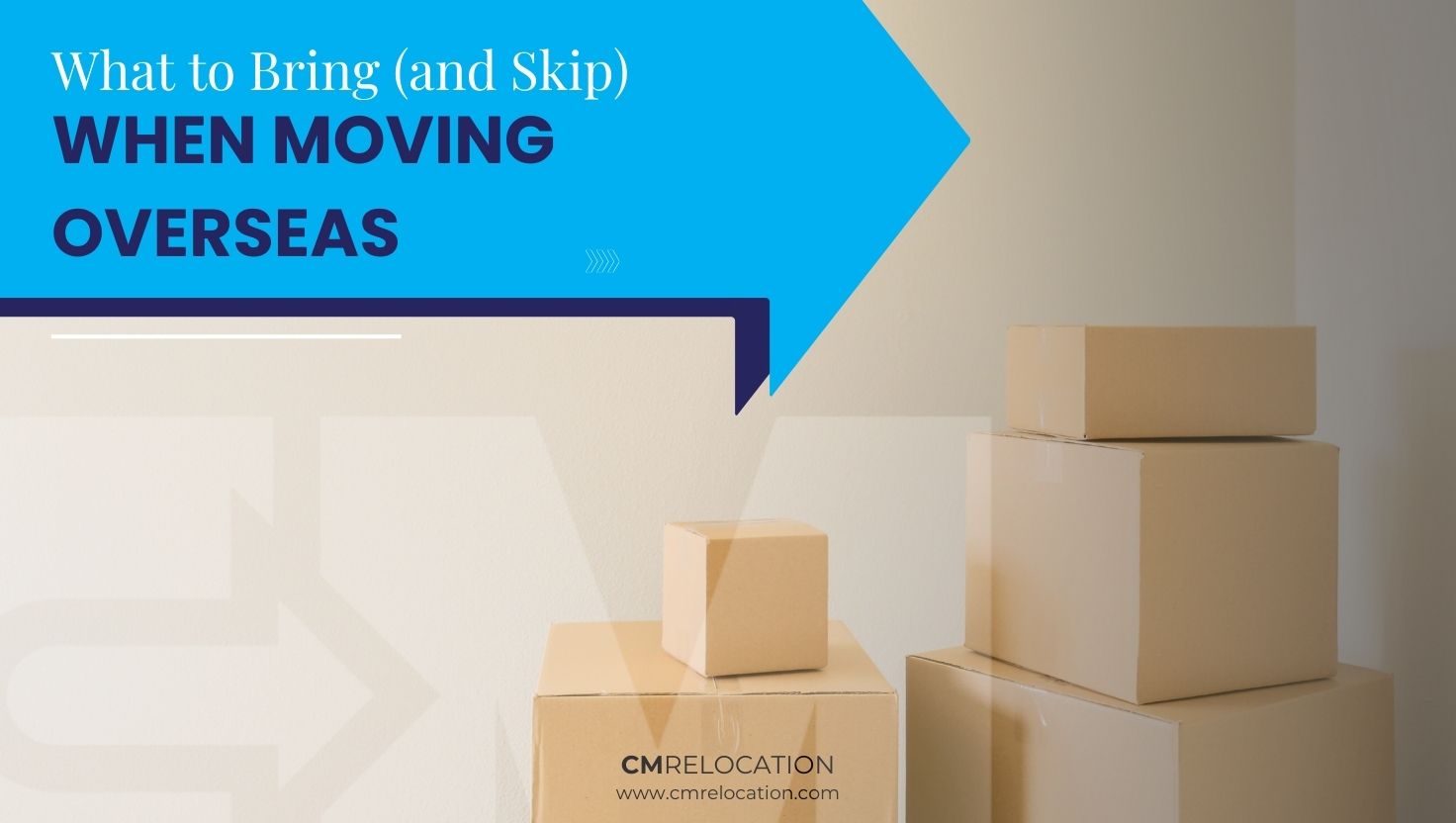
Planning an international move? One of the biggest questions you’ll face is: What should I bring and what should I leave behind?
Unlike a local move, an international relocation comes with unique considerations: shipping costs, customs regulations, space limitations, and different living standards in your destination country. It’s easy to overpack “just in case,” but in reality, packing strategically is the key to a smooth transition.
As a trusted international mover, CM Relocation has helped countless families and professionals relocate overseas. In this guide, we’ll walk you through how to decide what to take, what to leave behind, and how to pack smart for a new life abroad.
Start With a Simple Rule: Less Is More
Shipping costs for international moves are usually based on volume (cubic meters) or weight. The more you bring, the more you pay. That’s why we always recommend starting with this question:
“Do I really need this in my new home?”
If the answer isn’t a confident yes, it’s time to reconsider. Downsizing before the move saves you time, money, and stress.
What You Should Pack for an International Move
Here are the essentials and high-priority items most worth taking with you:
1. Important Documents
This is non-negotiable. Always carry the following with you (not in your shipment):
- Passport(s)
- Birth/marriage certificates
- Work visas or permits
- School records
- Medical and dental records
- Insurance documents
- Financial documents
- Pet vaccination records (if applicable)
Store digital copies on a secure cloud platform in case of loss or damage.
2. Seasonal Clothing & Personal Items
Pack clothing appropriate to your destination’s climate and lifestyle. Moving to Europe? Think layers. Heading to Australia? Pack for warmer weather and coastal living. Don’t forget:
- Everyday wear
- Business or work attire
- Activewear and swimwear
- Footwear
- Personal accessories and toiletries
- Prescription glasses or contact lenses
Try to avoid packing clothing you haven’t worn in over a year, as chances are you won’t need them overseas either.
3. Electronics & Gadgets
Yes, you can bring your favorite devices, but first check voltage compatibility and plug types in your destination country. Pack:
- Laptops, tablets, phones
- Chargers and adapters
- Headphones
- External drives
- Travel routers or power banks
Avoid bringing large appliances unless you’re sure they’ll work and meet local standards.
4. Sentimental or Irreplaceable Items
Think carefully about what holds personal value:
- Family photo albums
- Heirlooms
- Favorite books or artwork
- Gifts and souvenirs
- Baby or childhood keepsakes
While these items may not be essential, they provide comfort and familiarity during a big life change.
5. Essential Kitchenware & Household Items
Pack only a limited selection of durable, non-breakable kitchen items:
- High-quality knives
- Coffee/tea-making essentials
- Small appliances (if compatible)
- Spices you may not find abroad
You can replace many things at your new location but bringing a few essentials helps ease the transition.
What to Leave Behind When Moving Internationally
Not everything is worth shipping overseas. Some items can be sold, donated, or stored instead.
1. Bulky Furniture
Shipping large furniture is often expensive and impractical, especially if:
- It may not fit in your new home
- Your destination has furnished housing
- You can find affordable alternatives locally
Consider selling or donating big-ticket items like sofas, wardrobes, and dining sets.
2. Appliances
Different voltage systems and plug types make most home appliances difficult or dangerous to use abroad.
Unless you’re moving within the same region (e.g., from Singapore to Malaysia), it’s usually best to leave behind:
- Refrigerators
- Washing machines
- Microwaves
- TVs and entertainment systems
Buy new or secondhand appliances at your destination instead.
3. Excess Clothing
If your closet is overflowing, now’s the time to downsize. Leave behind:
- Clothes you no longer wear
- Outdated or climate-inappropriate outfits
- Duplicate items (how many jackets do you really need?)
Stick to versatile, seasonally appropriate clothing that suits your new lifestyle.
4. Non-Essential Decor and Collectibles
While these items may look great in your current home, they may not fit the style, space, or vibe of your new one.
- Vases, framed prints, table centerpieces
- Figurine collections
- Wall art
- Rugs and curtains
Unless it holds sentimental value, it’s better to start fresh in your new home.
5. Prohibited or Restricted Items
Every country has rules on what you can and cannot bring in. Commonly restricted or prohibited items include:
- Flammable liquids
- Certain plants and seeds
- Weapons or replicas
- Alcohol and tobacco (limits apply)
- Animal products
- Counterfeit goods
Important: Check with your moving consultant or customs authority before packing anything that might be restricted.
Bonus Tips for Efficient Packing
✔ Label everything. Use color-coded labels or room-specific tags for easy unpacking.
✔ Use vacuum-seal bags for clothing and linens to save space.
✔ Create an “Open First” box with essentials: chargers, bedsheets, toiletries, basic kitchen tools, and clothes for the first few days.
✔ Photograph your items before packing—useful for insurance claims or setup at your destination.
✔ Donate, sell, or store anything you’re unsure about. If you haven’t used it in the last 6–12 months, you probably won’t need it abroad.
Moving internationally is a fresh start but it doesn’t have to mean bringing everything with you. The key is to prioritise what matters, plan smart, and stay organised. With the right approach, you’ll feel more prepared, lighter, and ready to embrace your new home.
At CM Relocation, we’re here to help you make these decisions easier. From expert packing advice to professional customs guidance, our goal is to take the stress out of your move—so you can focus on what comes next.
Need help sorting your international move?
Book a free consultation with CM Relocation and get personalised advice on what to pack, what to leave behind, and how to ship smarter.
